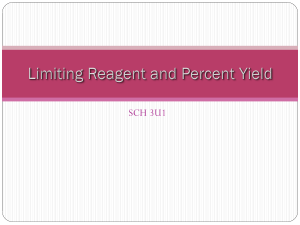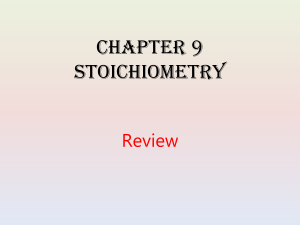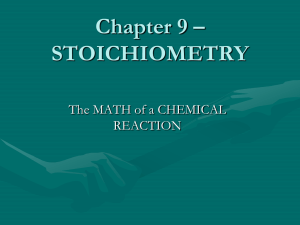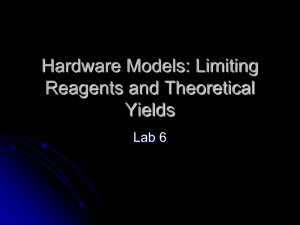Prerequisite Knowledge - Mira Costa High School
advertisement
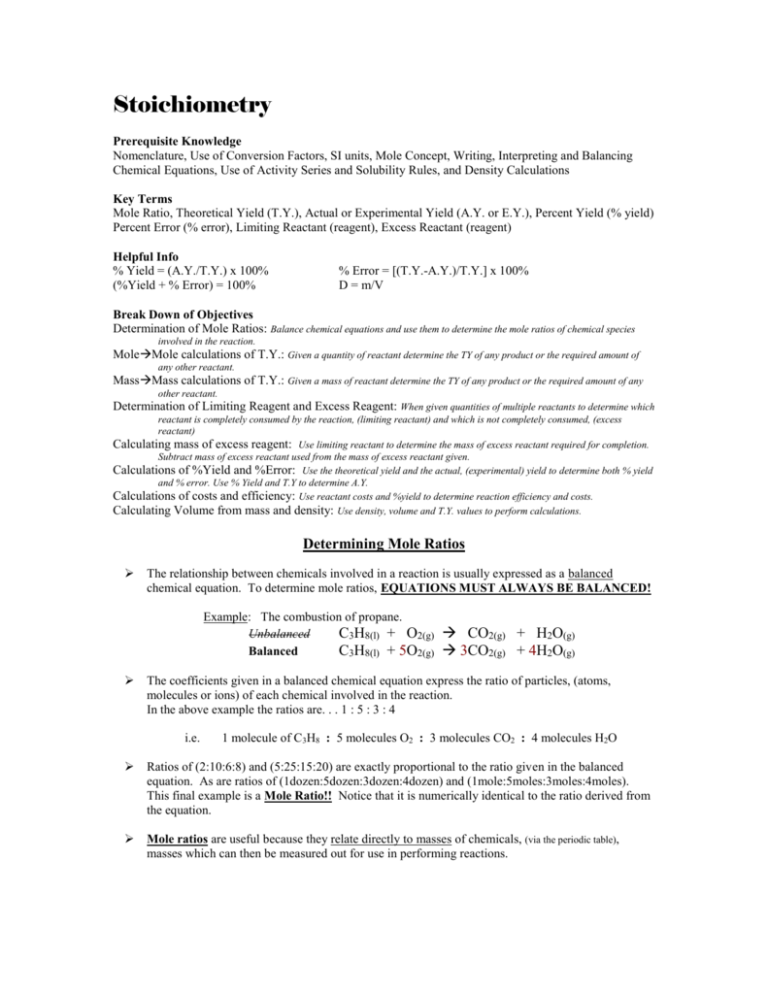
Stoichiometry Prerequisite Knowledge Nomenclature, Use of Conversion Factors, SI units, Mole Concept, Writing, Interpreting and Balancing Chemical Equations, Use of Activity Series and Solubility Rules, and Density Calculations Key Terms Mole Ratio, Theoretical Yield (T.Y.), Actual or Experimental Yield (A.Y. or E.Y.), Percent Yield (% yield) Percent Error (% error), Limiting Reactant (reagent), Excess Reactant (reagent) Helpful Info % Yield = (A.Y./T.Y.) x 100% (%Yield + % Error) = 100% % Error = [(T.Y.-A.Y.)/T.Y.] x 100% D = m/V Break Down of Objectives Determination of Mole Ratios: Balance chemical equations and use them to determine the mole ratios of chemical species involved in the reaction. MoleMole calculations of T.Y.: Given a quantity of reactant determine the TY of any product or the required amount of any other reactant. MassMass calculations of T.Y.: Given a mass of reactant determine the TY of any product or the required amount of any other reactant. Determination of Limiting Reagent and Excess Reagent: When given quantities of multiple reactants to determine which reactant is completely consumed by the reaction, (limiting reactant) and which is not completely consumed, (excess reactant) Calculating mass of excess reagent: Use limiting reactant to determine the mass of excess reactant required for completion. Subtract mass of excess reactant used from the mass of excess reactant given. Calculations of %Yield and %Error: Use the theoretical yield and the actual, (experimental) yield to determine both % yield and % error. Use % Yield and T.Y to determine A.Y. Calculations of costs and efficiency: Use reactant costs and %yield to determine reaction efficiency and costs. Calculating Volume from mass and density: Use density, volume and T.Y. values to perform calculations. Determining Mole Ratios The relationship between chemicals involved in a reaction is usually expressed as a balanced chemical equation. To determine mole ratios, EQUATIONS MUST ALWAYS BE BALANCED! Example: The combustion of propane. Unbalanced C3H8(l) + O2(g) Balanced C3H8(l) + 5O2(g) CO2(g) + H2O(g) 3CO2(g) + 4H2O(g) The coefficients given in a balanced chemical equation express the ratio of particles, (atoms, molecules or ions) of each chemical involved in the reaction. In the above example the ratios are. . . 1 : 5 : 3 : 4 i.e. 1 molecule of C3H8 : 5 molecules O2 : 3 molecules CO2 : 4 molecules H2O Ratios of (2:10:6:8) and (5:25:15:20) are exactly proportional to the ratio given in the balanced equation. As are ratios of (1dozen:5dozen:3dozen:4dozen) and (1mole:5moles:3moles:4moles). This final example is a Mole Ratio!! Notice that it is numerically identical to the ratio derived from the equation. Mole ratios are useful because they relate directly to masses of chemicals, (via the periodic table), masses which can then be measured out for use in performing reactions. Excercise #1: When sodium is combined with water a vigorous, exothermic reaction takes place producing sodium hydroxide and hydrogen gas. What is the mole ratio of sodium to hydrogen gas in this reaction? ID chemicals involved. Unbalanced equation Balanced equation Na(sodium), H2O(Water), NaOH(sodium hydroxide), and H2(hydrogen). Na(s) + H2O(l) NaOH(aq) + H2(g) 2Na(s) + 2H2O(l) 2NaOH(aq) + H2(g) Mole ratio of Na to H2 = 2:1 Excercise #2: Butane, C4H10 is a flammable liquid used in many lighters. Determine the mole ratio of butane to O2 in the combustion of butane. (2:13) Stoichiometry Assignment #1 Read pp. 320-321 Problems pg.321, 1-3 Pg. 324, 7-9 Quiz Mole to Mole Calculations Given a quantity of any chemical involved in a chemical reaction and a balanced equation describing that reaction, the quantities of every other chemical involved in the reaction can be determined. Given a quantity of one chemical, in moles, as a starting point multiply by the mole ratio to determine the number of moles of a second chemical involved in the reaction. (Refer to the Stoichiometry Map handout) Example: Calcium hydroxide, Ca(OH)2 is used in the manufacture of bleach Ca(OCl)2 in the reaction described by the following balanced equation. Given 12500 moles of calcium hydroxide how many moles of bleach can be produced? Ca(OCl)2(s) + CaCl2(s) + 2H2O(l) 2Ca(OH)2(s) + 2Cl2(g) 12500moles Ca(OH)2 (Given Quantity) 1mole Ca(OCl)2 2mole Ca(OH)2 x (Mole Ratio) 6250moles Ca(OCl)2 = 6.25 x 103 moles Ca(OCl)2 What this tells us is that if 12500 moles of calcium hydroxide completely reacts with excess Cl2 that 6250 moles of bleach should be produced. This quantity of product, determined by calculation is known as the theoretical yield, T.Y. It is theoretical because it is calculated based on the assumption that there are no errors in carrying out this process, that is no error in measurement, no impurities, no loss of product etc. In other words “perfection” thus it is a theoretical quantity. When a reaction is carried out in a laboratory or an industrial facility the quantity that is actually obtained is known as the actual yield, A.Y. also referred to as the experimental yield, E.Y. This quantity is usually, but not always, less than the T.Y. Stoichiometry Unit (Chap10) Quantitative Information from Chemical Equations Main Concepts: Mass/Mole relationships in chemical formulas, reactions and equations Limiting and Excess reagents determine the quantity of product and remaining reagent Percent Yield of a reaction and percent error Reactions in solution Molarity, molality, %concentration, ppm Objectives: Identify mole ratios in chemical reactions. Use mole ratios and molar mass relationships to create conversion factors for solving stoichiometric problems. Apply three-step method to solve stoichiometric problems. Distinguish between limiting and excess reagents. Identify the limiting reagent in a problem and calculate theoretical yield. Distinguish between theoretical yield and actual yield. Calculate % yield using theoretical yield and actual yield. Calculate actual yield using % yield and theoretical yield. Use stoichiometry to determine efficiency of fuels and economic factors involved in manufacturing. Tasks: Meet all of the above objectives. Pass three objectives quizzes (10pts/each) Complete all homework assignments (10pts) Complete lab prep/practicum (10pts) Complete stoich. lab (20pts) Complete Stoichiometry Exam (30pts)


